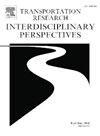利用导电加热器减少铁路道岔结冰:实验研究
IF 3.9
Q2 TRANSPORTATION
Transportation Research Interdisciplinary Perspectives
Pub Date : 2025-05-01
DOI:10.1016/j.trip.2025.101474
引用次数: 0
摘要
本文研究了一种用于铁路道岔减冰的导电加热系统的性能。一个基于实验室的实验装置旨在复制现实世界的铁路道岔(道岔)部分,包括一个导电电加热器夹在stock rail和下面的压载土层。对铁路道岔导电性加热器在寒冷环境下的性能和沿轨道表面的热量分布进行了评价。利用热电偶热传感器和红外摄像机测量钢轨表面温度分布。利用从热电偶收集的热数据对红外相机的结果进行了验证,结果表明红外相机可以在冬季气候条件下有效地远程监测轨道表面温度,并有助于减少与热电偶操作相关的现场维护需求。在潮湿、寒冷的气候条件下,观察到轨道加热器的显著性能恶化。加热器能效分析建议安装自动温度控制器,以保持轨道温度高于冰点,并根据当地环境条件调整最佳目标轨道表面温度以防止结冰。从轨脚到镇流器和周围环境的热损失被认为是另一个挑战。最后,该研究强调需要进一步研究轨道/加热器夹具的设计,材料和先进的绝缘技术,以提高轨道加热系统的效率和可靠性,并避免热量损失到镇流器和周围环境。本文章由计算机程序翻译,如有差异,请以英文原文为准。
Ice mitigation in railway turnouts using a conductive heater: An experimental study
This study investigates the performance of a conductive heating system for ice mitigation in railway turnouts. A lab-based experimental setup is designed to replicate real-world railway switch (turnout) sections, incorporating a conductive electrical heater clamped to stock rails and a ballast-soil layer beneath. The performance of the railway turnouts’ conductive heaters under cold environment conditions and the resultant heat distribution along the rail surface are evaluated. Thermocouple heat sensors and an infrared (IR) camera are used to measure the rail surface temperature distribution. The IR camera results are validated using thermal data collected from the thermocouples, and the results show that the IR camera can efficiently monitor the rail surface temperature remotely in winter climates and can help reduce the maintenance demands associated with thermocouple operation in the field. Significant performance deterioration of the rail heaters is observed under wet, cold climate conditions. Heater energy efficiency analyses suggest implementing automatic temperature controllers to maintain rail temperatures above freezing and adjusting optimal target rail surface temperatures for anti-icing based on local environmental conditions. Heat loss from the rail foot to the ballast and surroundings is identified as another challenge. Finally, the study highlights the need for further research on rail/heater clamp design, materials, and advanced insulation techniques to enhance the efficiency and reliability of rail heating systems and avoid heat loss to the ballast and surroundings.
求助全文
通过发布文献求助,成功后即可免费获取论文全文。
去求助
来源期刊

Transportation Research Interdisciplinary Perspectives
Engineering-Automotive Engineering
CiteScore
12.90
自引率
0.00%
发文量
185
审稿时长
22 weeks
 求助内容:
求助内容: 应助结果提醒方式:
应助结果提醒方式:


